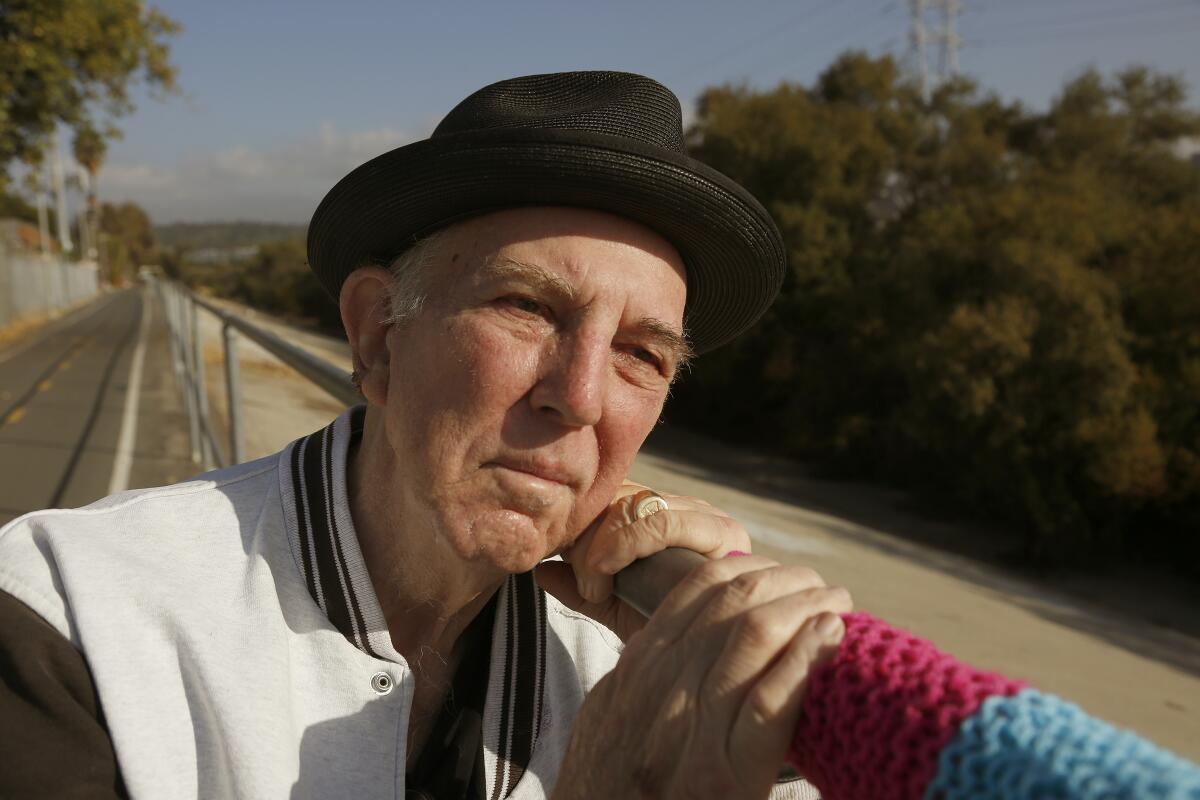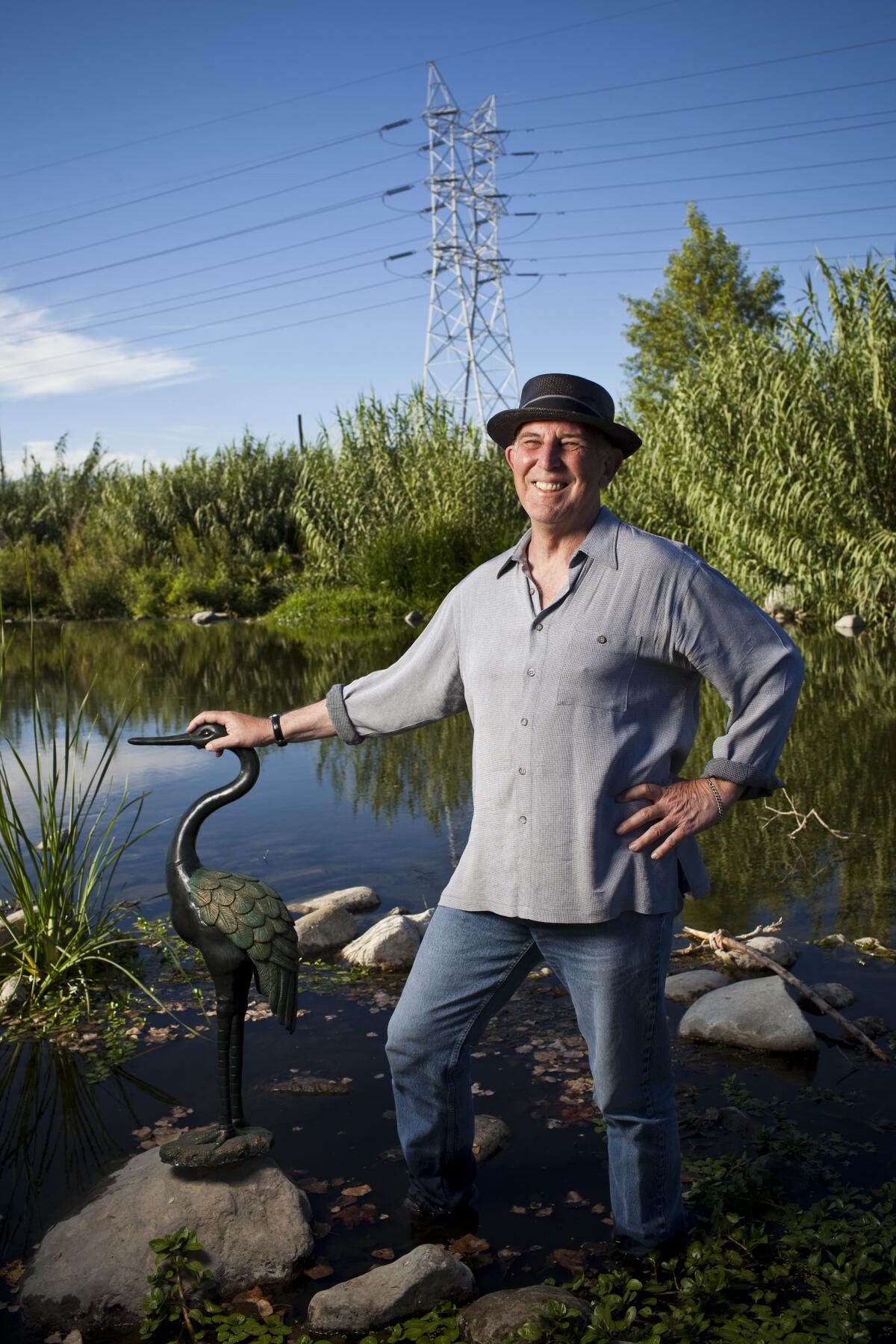Lewis MacAdams, famed crusader for the Los Angeles River, dies at 75

- Share via
Lewis MacAdams, a poet and crusader for restoring the concrete Los Angeles River to a more natural state and co-founder of one of the most influential conservation organizations in California, has died. He was 75.
MacAdams, who died of complications related to Parkinson’s disease early Tuesday at a healthcare facility in Los Angeles, was a visionary figure who led the hardened army known as Friends of the Los Angeles River and mentored generations of activists in fights to reduce the damage along the 51-mile flood control channel hemmed by freeways, power lines and railroad yards.
As the group’s first president, MacAdams was influential in making river restoration an issue for policymakers and transformed the nonprofit from a handful of nature lovers to an organization with a list of 40,000 supporters, annual river cleanup efforts and educational programs.
He also did much of the work to win approval of a $1.6-billion federal project to restore habitat, widen the channel, create wetlands and provide access points and bike trails along an 11-mile section of unpaved riverbed north of downtown.
In recognition of his contributions, a 7-foot-high concrete monument featuring artistic renderings of MacAdams in his trademark porkpie hat and flora and fauna such as cottonwood trees and red-legged frogs was installed in 2016 in a park along the river’s edge. The park was renamed Lewis MacAdams Riverfront Park.
In an interview later that year, MacAdams, who was recovering from a stroke, gripped the handles of his walker to steady himself and gazed out at a weedy stretch of concrete banks, listening intently.
“The L.A. River speaks to me,” MacAdams said “And she’s been a vigorous muse for more than 30 years.”
“There is a hole in the L.A. River,” Jon Christensen, a professor at the UCLA Institute of the Environment and Sustainability, said. “Lewis showed us the spirit of nature that could be found, revered, and recovered in its most altered and almost unrecognizable form in the Los Angeles River.”
While recuperating from ailments that made it hard for him to walk and speak, MacAdams was pressing ahead with his memoir: “Poetry and Politics.”
“Dad used to joke that he wanted to be a legend but ended up a lobbyist. Looking back on it all, he was both,” said his son Ocean.
MacAdams grew up in Dallas, the son of political activists. As a teenager, he rode his bicycle around that city singing “We Shall Overcome,” and was arrested for trying to integrate a Dallas restaurant.

Before moving to Los Angeles in 1980, MacAdams worked as a barker for strip clubs in San Francisco, ran the poetry center at San Francisco State, and sorted out environmental issues as a utility district commissioner in Marin County.
In 1986, he co-directed the documentary “What Happened to Kerouac?” which explored the life and times of Beat Generation author Jack Kerouac.
He found his calling one day that year when he and a few friends, fortified by coffee and brandy, used wire cutters to snip a hole in the fence that separated the concrete flood control channel from the city.
Walking along a stretch of the L.A. River just north of downtown, they asked it for permission to speak on its behalf, MacAdams recalled, adding: “We didn’t hear no.”
Friends of the Los Angeles River launched as a piece of performance art, staged in a skid row basement.
MacAdams donned a white suit and painted himself green to hearken the ghost of William Mulholland, chief engineer of the Los Angeles Aqueduct. Props included a massive totem pole made of junk found along the river.
“Everybody hated what we were doing,” MacAdams recalls in his memoir. “The reviewer for the Los Angeles Times said, ‘With friends like Lewis MacAdams, ‘the Los Angeles River doesn’t need enemies.’ ”
It was only one of many activities MacAdams and his cohorts were up to in the 1980s as part of their efforts to bring attention to the river.
Then there was the “bulldozer incident.” That was the time that MacAdams, clad in work clothes and rain boots, threw himself in front of three big D-10 Caterpillar tractor trailers as they were revving up to remove several large trees near the river’s confluence with the Glendale Freeway.
“We stopped the bulldozers that day,” he wrote.
The organization has been feeding visions of an urban oasis along the river ever since.
“Lewis wasn’t all that interested in scientific details — that wasn’t his mission,” said Melanie Winter, director of the nonprofit group The River Project and an expert on urban water and land use issues.
“He experienced the river and its potential as a giant conceptual poem,” Winter said.
The river was transformed into a flood-control channel in the 1930s to protect the burgeoning flatlands. Nearly the entire 51-mile channel was paved, except for a few spots north of downtown where the water table was too high.
Of concern to MacAdams, the last Southern California steelhead trout seen in the L.A. River was caught off a Glendale bridge in 1948 after that stretch of the river was paved for flood control. Steelhead are now an endangered species.
Awareness of the river as a natural resource and potential economic powerhouse began to grow in the late 1980s when environmental groups led by Friends of the Los Angeles River put pressure on the city, county and U.S. Army Corps of Engineers.
Ever since, the river’s permanent flow of warm treated runoff that smells like old socks has been slowly transforming into a greenbelt of parks, trees, bike paths and kayaking.
When environmental activist George Wolfe and a team of fellow explorers were preparing to undertake an unprecedented and unauthorized three-day float down the river in rafts one July morning in 2008, MacAdams presented him with an unforgettable gesture of support.
“He showed up just before we launched and handed me an authentic-looking ‘honorary passport to the L.A. River,’ ” Wolfe recalled. “It was a symbol of cooperation among people with the same goals.”
In 2010, the U.S. Environmental Protection Agency deemed the river navigable and subject to the protections of the Clean Water Act for its entirety, from Chatsworth to Long Beach. A year later, the U.S. Army Corps of Engineers permitted kayaking along a soft-bottom stretch about 17 miles north of downtown.
Now the river is targeted for another potentially uncomfortable historic change, this time involving recreational amenities and significant residential, commercial and office development, which could price longtime residents out of their homes.
In 2016, MacAdams stepped down to allow new leaders to take the reins of Friends of the Los Angeles River. Their priorities included mending the nonprofit’s rift with architect Frank Gehry and River LA, a group founded to pursue economic opportunities along the river.
A year earlier, MacAdams was dismayed to learn that Gehry for several months had been working behind the scenes on a new master plan for the river with the approval of powerhouse business leaders, River LA and City Hall officials led by Mayor Eric Garcetti.
Worried that the project would undermine his group’s efforts to secure funding for the $1.6-billion proposal to restore habitat, MacAdams refused to endorse the Gehry effort. Garcetti, though, remained one of MacAdams admirers.
“Lewis was my creative writing teacher in high school and the first deep poet I ever met in my life,” Garcetti recalled Tuesday. “I knew him as a cooler than cool guy with a lot of layers and courage, whose words were measured, profound and sparse, and affected the lives of the people they reached.”
“Lewis took that same approach to his activism,” the mayor added. “He showed us how the Los Angeles River was as much about our souls as about a material place. To him, the river was the most democratic of places, and he zealously guarded it.”
In semi-retirement, MacAdams came up with another approach to the arc of his own existence and plunged deeper into his memoir, using his characteristic wry humor and thoughtfulness to instill a sense of appreciation in others for his “art project,” the river.
Marissa Christiansen, president and chief executive officer of the nonprofit, said MacAdams, like the river itself, “led a winding, fabled and momentous life -- the kind that will live on in the memories of everyone he knew.”
Not surprisingly, friends and admirers had been nagging MacAdams for years to answer this question: “How will you know when you’re done?”
The answer comes on page 110 of his unfinished memoir.
“When steelhead trout return to the L.A. River,” he wrote, “our work will be done.”
MacAdams is survived by his brother Alan; his sister Kathy; sons Ocean, Will and Torii; his daughter Natalia, and his companion, Sissy Boyd.
More to Read
Start your day right
Sign up for Essential California for the L.A. Times biggest news, features and recommendations in your inbox six days a week.
You may occasionally receive promotional content from the Los Angeles Times.







